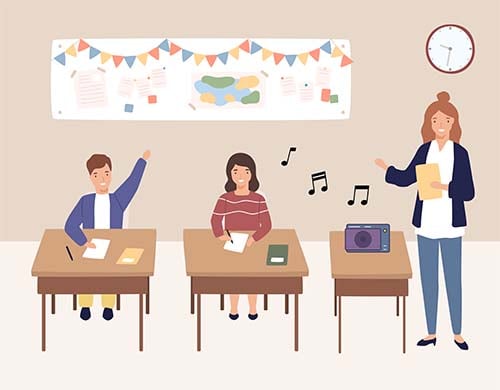Using Song Gap-fills with ESL Students

Songs are an enjoyable way for students to learn English. They provide students with an authentic source of English language usage. Using music in class has many benefits and musical activities can be used regularly to help improve your students' listening skills. Before you do a song gap-fill with your students, there are a few things you should consider.
Have a Purpose
First, think about the purpose for doing a song gap-fill. Make sure you have a clear purpose for listening to a song in class. Don't do a song gap-fill for the sake of it or to fill in time. This will come across as a waste of time to your students. In other words, have a clear and specific point in mind for the song gap-fill.
Do you want to concentrate on listening or reading skills?
Generally, shorter slower songs are used to improve listening skills, and longer songs are used to practice reading. Also, you can use a song with repetitive lyrics to concentrate on pronunciation and language structures.
Do you want to use a song to review a recently covered topic or introduce a new one?
Using a song helps to create interest in a topic and focuses the students' attention. It also provides students with a context for using the language.
Do you wish to use a song to introduce or revise vocabulary or a language point?
Many websites cater to teachers looking for songs. By searching online, you can easily find a song that relates to a particular tense, grammar focus or vocabulary set.
If you are teaching a fairly advanced group of students, you could use songs to teach slang expressions or idioms. Advanced students are usually keen to learn slang terminology and idioms as this helps them to sound more fluent.
Designing a Song Gap-fill
Once you have established a clear purpose, it is then important to think about designing your song gap-fill. Here are a few tips you might consider:
Will the students be interested in your song choice? Don't just choose a song that suits your own particular tastes. Try to choose a song that will best suit the purpose of the gap-fill. If it is a modern song that the students like, all the better.
You will also need to think about the content of the song. Songs with explicit lyrics are best avoided.
Depending on the length of the song, you should take out 15 to 20 words or phrases that you wish to concentrate on. Number all the missing words or phrases in the song gap-fill. If you are considering taking out short phrases rather than single words, the gap should be no more than three words long.
For lower levels, it may be a good idea to give the first letter of the missing word and indicate the number of letters in each word with underscored dashes. You might consider providing a word bank from which students select the missing words they hear. It is also possible to provide clues such as synonyms in brackets either directly before or after the gap.
As a variation, rather than getting students to fill in the missing word, you could insert extra words into the text and have students cross out the words not included in the lyrics as they listen. Similarly, you could replace words and ask students to listen for the errors and correct them accordingly. For instance, instead of "I read the news today, oh boy..." use "I read the news today, oh man..."
A Basic Framework for Using Song Gap-fills
When using song gap-fill activities in class, it is important to follow the same basic framework used for any listening activity.
First, there should be a pre-listening activity. This provides an opportunity for students to activate ideas or background knowledge connected to the song's main theme. At this stage of the activity, the teacher could pre-teach any critical or challenging vocabulary, ask students to discuss warm-up questions in pairs or groups, or ask them to predict the content of the song.
Next, there is a listening stage where students listen to the song and complete a task. In our case, a gap-fill.
Finally, there needs to be a post-listening element to the activity. This could involve students analysing new vocabulary or discussing any particularly interesting lyrics and their intended meaning. This could then be followed up with a speaking or writing activity that explores the topic or theme of the song or any vocabulary or grammar that the song highlights.
A Variation on the Typical Song Gap-fill
In a typical song gap-fill, students listen along and fill the blanks with the words they hear. However, what can often happen is that they may have gotten the base word correct but have written the wrong word form. This is partly because they are primarily focused on what they hear rather than focusing on how the word is being used in the sentence. It is also because of pronunciation differences between language that is spoken and language that is sung.
To help mitigate this problem, do a pre-listening activity that gets students to focus on the form of the missing word. This can be achieved by presenting a pre-listening version of the lyrics that include clues in the brackets immediately before the gap.
Before the listening, get students to read through the lyrics and use the clues to guess the missing words by filling the space marked (G) for guess. Then play the song and as students listen, they write their answers in the spaces marked (A). In the example below, the answer for 1. Is ‘platform’ and the answer for 2. Is ‘train’.
Well, one foot is on the (similar to a stage) 1. (G) _ _ _ _ _ _ _ _ (A) _ _ _ _ _ _ _ _
And the other one’s on the (a form of transport) 2. (G) _ _ _ _ _ (A) _ _ _ _ _
Song Gap-fills as Games
Listening to music is a joy on its own, but song gap-fills can be made even more enjoyable by turning them into a competitive game. Below is a general procedure for turning a song gap-fill into a fun game experience.
Divide the class into small teams and assign each team with a number.
On the board, write the title of the song and the numbers of the missing words.
Hand out a copy of the gap-fill to each student.
Have the students listen to the song three times.
Students should work on their own the first two times they listen to the song.
After you have played the song a second time, have the students compare their answers with their teammates.
Give the students time to discuss their answers and then play the song a final time.
After that, teams take it in turns to write their answers on the board. A team chooses a number. Then, a team member comes to the board and writes the missing word.
Teams score one point for a correct word and an extra point for spelling. If a team spells a word incorrectly, ask the other teams to give the correct spelling. If another team gives the right spelling, award them with the spelling point.
Continue like this until all the missing words have been written on the board. If the teams are struggling, play the song one more time.
Afterwards, announce the winning team and discuss the meaning of the song. Get feedback from the students on their ideas and opinions and round off the activity.
Final Thoughts
As mentioned previously, song gap-fills are a fun and versatile activity for helping students improve their English. While they obviously help improve listening skills, they can be used to help teach particular language points related to grammar and vocabulary, and they can even be turned into fun games. It is also important to remember that creating and using song gap-fills involves more than simply creating gaps in a text and hitting the play button. Therefore, it is hoped this short article has given you are few simple ideas to help you create and utilise song gap-fills more effectively.



